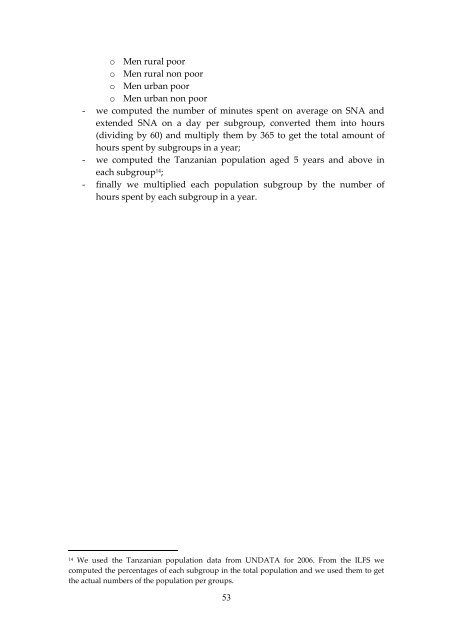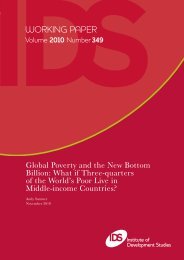Patterns of time use in Tanzania: how to make public investment in ...
Patterns of time use in Tanzania: how to make public investment in ...
Patterns of time use in Tanzania: how to make public investment in ...
You also want an ePaper? Increase the reach of your titles
YUMPU automatically turns print PDFs into web optimized ePapers that Google loves.
o Men rural poor<br />
o Men rural non poor<br />
o Men urban poor<br />
o Men urban non poor<br />
- we computed the number <strong>of</strong> m<strong>in</strong>utes spent on average on SNA and<br />
extended SNA on a day per subgroup, converted them <strong>in</strong><strong>to</strong> hours<br />
(divid<strong>in</strong>g by 60) and multiply them by 365 <strong>to</strong> get the <strong>to</strong>tal amount <strong>of</strong><br />
hours spent by subgroups <strong>in</strong> a year;<br />
- we computed the <strong>Tanzania</strong>n population aged 5 years and above <strong>in</strong><br />
each subgroup 14 ;<br />
- f<strong>in</strong>ally we multiplied each population subgroup by the number <strong>of</strong><br />
hours spent by each subgroup <strong>in</strong> a year.<br />
14 We <strong>use</strong>d the <strong>Tanzania</strong>n population data from UNDATA for 2006. From the ILFS we<br />
computed the percentages <strong>of</strong> each subgroup <strong>in</strong> the <strong>to</strong>tal population and we <strong>use</strong>d them <strong>to</strong> get<br />
the actual numbers <strong>of</strong> the population per groups.<br />
53

















